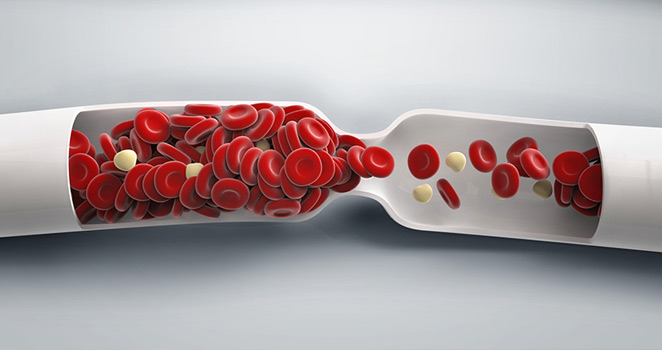Atrium Health Navicent Heart & Vascular Care
Endovascular Interventions for Deep Vein Thrombosis

Deep venous disease and Deep Vein Thrombosis (DVT) of the lower extremities is both prevalent and debilitating. Symptoms of DVT can be chronic, such as post-thrombotic syndrome. It can sometimes even lead to death, particularly when connected with a pulmonary embolism or venous ischemia. Overall, DVT places both a personal burden on the patient and a serious economic burden on society.
In 2008, The United States Surgeon General told the public that DVT was a real threat. DVT is one of the top three most prevalent cardiovascular diseases in the world. This is why endovascular intervention for deep vein thrombosis is so important.
Symptoms of DVT
There are different consequences for acute patients and chronic patients. Overall, the initial consequences of DVT are very serious and include:
- Lower extremity problems
- Risk of pulmonary embolism
- Death
Longer-term consequences include:
- Recurrent DVT
- Ulceration
- Hypertension of the lower extremities
- Limping
- Pain
- Swelling
DVT, Pulmonary Embolism and Anticoagulants
Pulmonary embolism has a very high rate of fatality. Often, treatments for DVT are aimed to prevent pulmonary embolism. To do this, anticoagulant drugs are used. First, the patient is given a parenteral anticoagulant and is then transitioned to an oral Vitamin K for a minimum of three months. The length of the treatment depends on how likely it is for pulmonary embolism to occur. In patients who have cancer, the anticoagulant that is used is a low molecular weight heparin. The treatments last from three to six months.
In 2012, the FDA approved the oral treatment rivaroxaban, which is to treat venous thromboembolism. This treatment is popular because it does not have as many drug interactions as warfarin does and it is not affected by diet. However, while anticoagulation treatments are able to prevent the propagation of blood clots, but this can be a slow process. Before the clot is completely resolved, there is a prolonged period of vein obstruction, which can lead to valvular damage. This can lead to post-thrombotic symptoms. As a solution, early clot removal can prevent the issues associated with DVT without damaging valve function. Several solutions involving endovascular intervention for deep vein thrombosis have been proposed.
Endovascular Intervention for DVT
Patients who have a good life expectancy and who have DVT of the lower extremities should be considered for endovascular intervention. Treatments include:
- Catheter-Directed Thrombolysis (CDT): Thrombolytics are infused into the venous thrombosis. This limits exposure to drugs. An infusion catheter is placed near to the thrombus and is externally secured; thrombolytics are delivered via the catheter. Patients are placed in the ICU for monitoring. Venography is used to determine clot lysis; this repeats every 24 hours until the clot is completely disintegrated. CDT is beneficial for the following DVT consequences:
- Early clot resolution
- Recurrent DVT prevention
- PE prevention
- Valve preservation
- Ultrasound-Accelerated Thrombolysis: Clot disruption is achieved through low power, high-frequency ultrasound waves along with thrombolysis via a catheter. The ultrasound waves create micro streams that make the thrombus more permeable. The waves also go past the valves, which mean there can be thrombus removal in areas that are not accessible with other devices. The catheter is able to measure temperature and flow pattern changes and the process continues until completely clot lysis is achieved.
- Percutaneous Mechanical Thrombectomy (PMT): This treatment results in early removal of the thrombus. It also limits the number of thrombolytic doses needed and limited the number of bleeding complications. This treatment is ideal for patients who cannot have lytic therapy because it is the only DVT treatment device, which does not require thrombolytic.
Continued Work Toward a Solution
At the time, there is not a solution for very serious bleeding. While there is still work to be done in order to understand deep vein thrombosis, there has been quite a bit of progress in the field. There are now techniques that help to reduce bleeding. Doctors can also remove thrombus. Endovascular recanalization is a good alternative to open surgery and has a lower rate of fatalities.